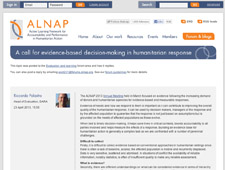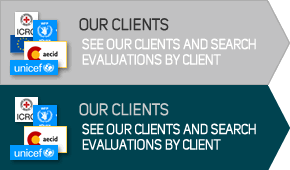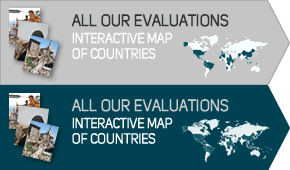April 24, 2013
Source: ALNAP
 By Riccardo Polastro
By Riccardo Polastro
The ALNAP 2013 Annual Meeting held in March focused on evidence following the increasing demand of donors and humanitarian agencies for evidence-based and measurable responses.
Evidence of needs and how we respond to them is important as it can contribute to improving the overall quality of the humanitarian response. It can be used by decision makers, managers of the response and by the affected population to guarantee that the response is not just based on assumptions but is grounded on the needs of affected populations as these evolve.
When tied to timely decision-making, it helps save lives in critical contexts, boosts accountability to all parties involved and helps measure the effects of a response. Building an evidence base for humanitarian action is generally a complex task as we are confronted with a number of perennial challenges.
Difficult to collect
Firstly, it is difficult to collect evidence based on conventional approaches in humanitarian settings since there is often a lack of baseline, access; the affected population is mobile and recurrently displaced. Data is very sensitive, scattered and atomised. In situations of conflict the availability of reliable information, notably statistics, is often of insufficient quality to make any reliable assessment.
What is evidence?
Secondly, there are different understandings on what can be considered evidence in terms of hierarchy and robustness. Today, the humanitarian system is confronted with two differing approaches that some qualify as wars: one that champions the use of randomised control trials, and one that champions local knowledge (see John Mitchell’s blog Avoiding ‘evidence wars’ in humanitarian aid). Regardless of the approach, evidence should be regularly verified and contrasted as it can soon become outdated as needs evolve.
To be valid, evidence must be accurate, representative, significant and attributed to a specific response or the overall response. Furthermore as actors within the humanitarian system we need to understand the hierarchy of evidence, at least if we want to have a grounded approach and be reliable in our response.
Feedback to beneficiaries
There is also an issue of beneficiary participation. In most humanitarian responses, evidence collection tends to be very extractive and there is limited, if any, feedback to the affected population, on what will be provided, by whom and by when, or how will the response adapt or evolve following assessments, monitoring or evaluation missions of organisations. The feedback mechanism to the primary target of the international response is missing.
Participatory processes to define methods, understand changes and challenges are seldom used. The response is generally an exogenous solution that is supply-driven rather than needs- based, delivering what we have rather than what is needed and building on existing local capacities. In the long run, this limits exit strategies and self-sustainability.
Looking ahead
More needs to be done by agencies to ensure that they do their best to take decisions based on evidence, without compromising a speedy response in the process. Humanitarian organisations might want to:
• Base their response on needs and less on working assumptions and anecdotal evidence.
• Keep the politics out to preserve an independent and neutral humanitarian response that is needs-based.
• Build ownership of key stakeholders and decision makers, prioritise the affected population. Evidence gathered should be shared – when this does not compromise the security of the affected population and staff.
• Understand what and when data is needed. Fundamentally identify who needs what information and for what purpose and by when. Used in real time, it may help to save lives as could have been done during the Horn of Africa drought by tying early warning to early decision-making and response.
• Spend more time listening to affected populations as a way of gathering evidence of needs.
• Learn and identify context-specific good practices for data collection even in remotely managed contexts.
If you are actively gathering and using evidence data to meet the needs of affected populations, why not share your views here?




Share this